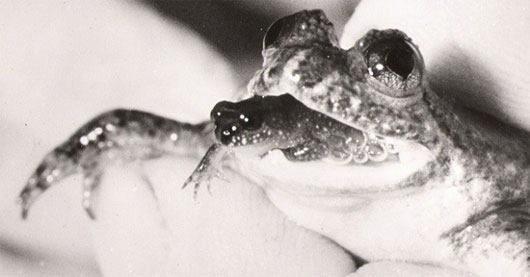Extinct animals have the opportunity to
Mammoths, Tasmanian tigers or stomach frogs . are animals that have the opportunity to "live" again.
Along with the rapid development of human society, the natural environment is shrinking with dizzying speed, leading to the extinction of countless different animal species.
However, with the development of science, some of them still have the opportunity to 'live' again.
1. Frogs hatch eggs with stomach
The Gastric Brooding Frogs (GBF), whose scientific name is Rheobatrachus, is a native Australian frog found in 1972.
Because of the small number of GBF frogs discovered and then shortly after, in 1983, they were declared extinct. At that time, due to the lack of scientific and technical development, scientists did not have the conditions to further study this species.
GBF frogs have a quite different point: hatching eggs with the stomach. Immediately after laying eggs, GBF immediately swallowed the eggs into the stomach - all of the stomach acid was now transferred to another container so as not to harm the newborn eggs.

When their stomachs are full of eggs, eggs will be pulled straight down to the uterus and after the eggs hatch, the frogs will be vomited through the mouth.
In 2011, Professor Michael Archer and his team succeeded in replicating some GBF cells by analyzing the DNA of striped frogs - the closest relative to GBF.
Even so, this cell is not yet complete and needs more research. Besides, the subjects to study - striped frogs only reproduce twice a year, will cause the work progress to be reduced quite a lot.
2. Thylacine species
Thylacine is commonly known as the Tasmanian tiger or Tasmanian wolf.

This creature first appeared in Papua New Guinea but later, only in South Australia
They are a predator with very strong teeth, a sharp bite that is three times stronger than a dog of the same size.
The cause of their direct extinction is due to human migration. Europeans who migrated to Australia lived, cultivated and raised their own territory, not only that, but they also considered Thylacine the culprit to attack their flock so they issued a hunting order.
For every Tasmanian tiger, the hunter will be awarded a great prize, so of course, they were hunted to near extinction. The Tasmanian tiger was finally known to die in the zoo in 1936, officially putting an end to its existence.
However, a few bodies of Thylacine have been stored in the Melbourne Museum. In 2008, scientists used this source to 'patch' their genome, insert into a mouse embryo and begin the process of 'regenerating' their extinct animals.
3. Irish elk
With the alternative host method - that is, transplanting an organism's cells into the embryo of another creature to create the same creature, the regeneration of Irish elk - one of the largest deer The world is no longer too difficult.

This giant deer species has a shoulder height of up to 2.1m, a pair of horns nearly 4m long, weighing up to 40kg and an average body weight of about 600kg
But fortunately, with a single fossil remains of this species, researchers at the University of London are gradually completing a complete genetic map; Since then, the cell rebuilding of this deer is based on its relatives.
Researchers are still trying to find the right alternative host, and to answer the question, is today's environment suitable for this Irish elk?
4. Mammoth
Mammoth rebirth is thought to be a tremendous dream for scientists because it can help open new directions for the Ice Age.

In 2011, a research team in Tokyo announced that they would produce a mammoth within 2 years by using a host technique instead. However, it seems that this is more difficult than expected.
Being under the snow for such a long time cannot guarantee that the cells are intact and their ability to function after "defrosting" is not really good. As a result, after many experiments, they still couldn't create a complete cell.
The prospect of reproducing ancient species has been noticed by the scientific community as they plan to extract the stem cells from the mammoth corpse to collect DNA to recreate the ancient species. This technique requires cells to be healthy despite spending thousands of years under the ice. However, scientists hope that, in this way, the reproduction of mammoths is no longer too far away.
- Mammoths and extinct animals are about to be revived
- Development technology revives extinct species?
- Animals are only in legend
- Regenerating extinct animals
- 10 animals make humans extinct if revived
- The evolution of animals does not keep pace with extinction
- The reasons for extinction of animals are more difficult than we imagined
- Tail pieces can help revitalize extinct bison 12,000 years
- Extinct animals are forgotten by humans
- 95% of lemurs are about to become extinct. What is happening?
- Opportunity Robot is suffering from dementia
- The world is about to regenerate an extinct cow
 Animal 'suffering' after hibernation
Animal 'suffering' after hibernation Why do goats climb well?
Why do goats climb well? Scientists were surprised to see chimpanzees eating turtles
Scientists were surprised to see chimpanzees eating turtles Giant catfish died deadly due to drought in Thailand
Giant catfish died deadly due to drought in Thailand